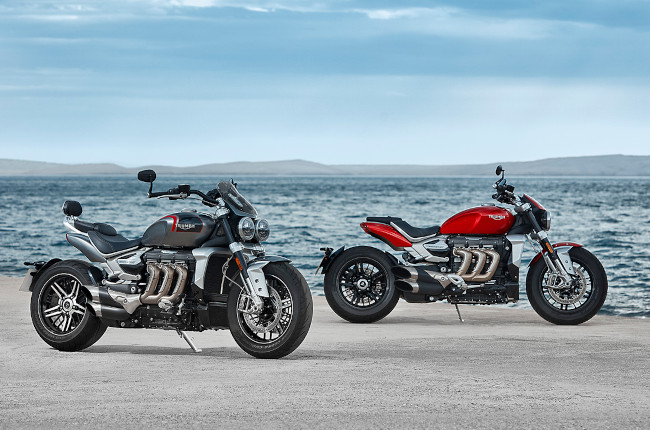5 things that make the Triumph Rocket 3 stand out from the crowd
This bigtime cruiser packs quite the punch.

When Triumph launched the revised Rocket 3 into the global market last year, the British manufacturer gave new meaning to the saying “bigger is better.” Today, the current generation Triumph Rocket 3 boasts one of the largest production engines found in any motorcycle, and packs quite a punch in the performance side of things.
In the Philippine market, we’ve begun to see this heavyweight cruiser in the wild more often, with more and more people choosing this bike as their weapon of choice—be it for weekend rides, or the daily commute. Having said all that, here are 5 things we love about the Rocket 3, and why it’s worth your hard-earned cash.
The power

The words “Triumph Rocket 3” and “torque” are all too commonly used in the same sentence—and rightfully so. As mentioned earlier, the Triumph Rocket 3 boasts the largest engine found on any production motorcycle currently available in the market. Displacing a whopping 2,458cc, the Rocket 3’s engine is bigger than most cars’ engines in the local market. Employing a three-cylinder configuration, the Rocket 3 churns out a neck-snapping 163 ft-lbs of torque and 165 horsepower. This makes this heavyweight cruiser quite the rowdy machine, especially when it comes to outright acceleration.
Head-turning styling

As much as the Rocket 3 is a performer, it’s also quite the looker. With head-turning styling that’s sure to make you the center of attention anywhere you go, the bike employs modern-day styling with a nod to Triumph’s signature design language. Its long wheelbase further accentuates the bike’s heft, while its muscular fuel tank, thick tires, and beefy suspension exude performance. Just like Triumph’s other street-oriented machines, the Rocket 3 gets a twin-headlight setup which gives it an unmistakable appearance when it’s approaching you from head-on.
Rich heritage

Triumph first introduced the Rocket 3 in 2004, under the Rocket III moniker—denoted by Roman numerals. Just like the current bike, it boasted a massive engine with a displacement of 2,294cc. Just like the modern-day version, it made use of an inline-three-cylinder layout, and pumped out loads of power and torque. The first-generation Rocket III was also quite the design exercise for the Hinckley company, serving as a major departure from the company’s svelte and streamlined design language. These days, the modern-day Rocket 3 slots perfectly into Triumph’s street-oriented lineup, and is the dream machine of many two-wheeler enthusiasts looking to get into cruisers.
Comfort

Given the Rocket 3’s hefty size and weight, as well as all the power it packs between your legs, it’s easy to mistake this bike as quite the unwieldy monster. However, it’s actually quite an approachable machine. With its upright ergonomics, cushy seat, and low seat height, the Rocket 3 is a very comfortable machine which is ideal for long-distance touring. The bike has also proven to be very light on its feet, lending itself to rather spirited riding, contrary to what its appearance would suggest. Granted, of course, the Rocket 3 is no beginner’s machine. However, it can certainly offer quite a comfy ride.
The price

The Triumph Rocket 3 is, without a doubt, one of the most premium cruisers in the local market. In fact, it holds the spot as the most expensive motorcycle in Triumph’s model range. That said, it certainly carries with it all the luxurious bells and whistles you’d expect from a motorcycle of this caliber. It will also surely make you the center of attention when it comes to bike nights and hangouts with your riding buddies. Starting at P1,590,000, the Rocket 3 is also available in a touring-oriented GT variant, which will set you back an even steeper P1,650,000.
Related Articles
-
Ride a naked sportbike? Get these 5 upgrades first / Featured Article
Here’s a quick list of 5 upgrades to your naked sportbike to enhance your riding experience.
-
Motorcycle 101: The inner workings of a slipper clutch / Featured Article
Slipper clutches are awesome as they make for more forgiving downshifts and a lighter clutch lever. Let’s take a closer look at them and see how they work.
-
3 reasons why the Ducati Monster is the best everyday Ducati / Featured Article
If you’re looking for a Ducati to ride on a daily basis, look no further than the new Ducati Monster.
-
5 things to remember when shopping for new motorcycle tires / Featured Article
Here are 5 things to consider when time comes for you to replace the tires on your motorcycle.
-
The Kawasaki Ninja 650 is still one of the best value for money sportbikes—here's why / Featured Article
Here are a few reasons why Kawasaki’s Ninja 650 is one of the best value for money middleweight sportbikes in the market.
Latest Features
-
Last-minute Christmas gift ideas for your rider friends and family / Featured Article
Struggling to think of gift ideas for your motorcyclist friends and family? Read on to get some inspiration this gift-giving season.
-
Ride a naked sportbike? Get these 5 upgrades first / Featured Article
Here’s a quick list of 5 upgrades to your naked sportbike to enhance your riding experience.
-
Motorcycle 101: The inner workings of a slipper clutch / Featured Article
Slipper clutches are awesome as they make for more forgiving downshifts and a lighter clutch lever. Let’s take a closer look at them and see how they work.







